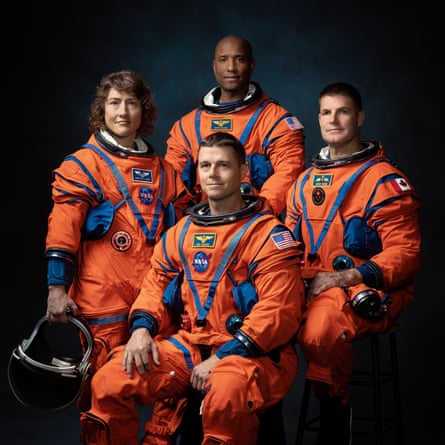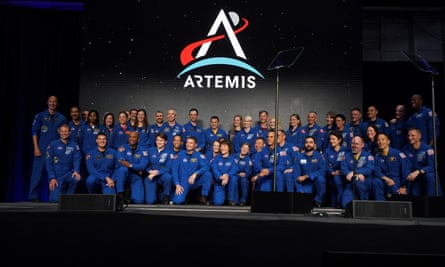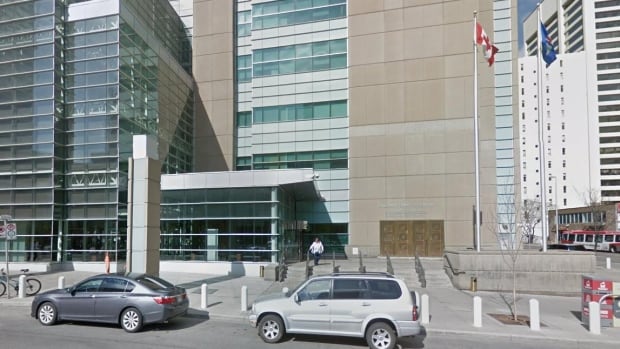Tech
‘We go for all and by all’: Artemis II crew certain of moon mission success

|
|
At a press conference on 5 July 1969, 11 days before the launch of Apollo 11, Neil Armstrong, Buzz Aldrin and Michael Collins sat on stage in a plastic box with blowers making sure they did not inhale airborne germs from the sizeable gathering of journalists.
Asked about the risk of getting stranded on the moon, Armstrong replied: “Well, that’s an unpleasant thing to think about.”
More than half a century later humans are now finally going back to earth’s nearest neighbour and, once again, obliged to sell the enterprise to the public. The four astronauts – three Americans and a Canadian – who will fly around the moon on Nasa’s Artemis II came to Washington last week to charm members of Congress and the media.
The turnout for a press conference at the Canadian embassy was more modest than for Armstrong and co. Instead of a plastic box, the blue flight suited astronauts spoke in an open air courtyard dominated by The Spirit of Haida Gwaii, a bronze sculpture of 13 mythological figures in a canoe.
But the most obvious break from the Apollo era was the diversity of the crew.
Christina Koch is the first woman and Victor Glover the first person of color assigned to a lunar mission. Nasa administrator Bill Nelson has called it “humanity’s crew”. The agency that does its best to stay above the political fray is aware of the potency of representation when it comes to public support and congressional funding.
Koch, mission specialist, noted on Wednesday that the many teams working on the mission “are a little bit different than the last time we went back to the moon, because we are going in an era this time where we go for all and by all, where everyone who has a dream and who’s willing to work hard on that dream is welcome at the table to contribute, and we’re going to be more successful as a result”.
Koch grew up in Jacksonville, North Carolina, and spent summers on her family’s farm in Michigan. She studied electrical engineering at North Carolina State University in Raleigh, North Carolina, and was selected as a Nasa astronaut in 2013.
Koch holds the world record for the longest spaceflight by a woman with a total of 328 days and took part in the first all-female spacewalks. The Nasa website says she enjoys “backpacking, rock climbing, paddling, surfing, running, yoga, community service, photography and travel”.
Glover, pilot, was born in Pomona, California, and holds various qualifications in engineering and military operational art and science. He joined the navy while still in college, was a test pilot in F-18 fighter jets and flew combat missions in Iraq. He was working as a legislative fellow in the office of Senator John McCain in 2013 when he was selected as an astronaut.
Glover served as pilot and second-in-command on the SpaceX Crew Dragon Resilience and became the first Black astronaut to live on the International Space Station as part of a long-duration mission. During 168 days there he completed four spacewalks, spoke with vice-president Kamala Harris and delivered a university commencement address.
On Wednesday the Guardian asked both Koch and Glover about the challenge of growing up without obvious role models in a space program dominated by white men. Did they run into a set of assumptions from parents, teachers and others about who an astronaut is – and isn’t?
Koch replied: “When you look at the missions from 50 years ago, they looked very different than what you’re seeing here and I feel fortunate that, when I told my kindergarten teachers and all the teachers after that, I wanted to be an astronaut, they supported me. No one told me that that was unattainable. .
“What I can credit is people believing in me but also the role models I had. Even though I had never seen a female engineer in my small town in North Carolina, I did see people that believed in something and were brave enough to pursue what they believed in. Those were my heroes in North Carolina of the civil rights movement, who I learned about.”
Koch also named Sally Ride, who in 1983 became the first American woman to fly in space, and Mae Jemison, who in 1992 became the first African American woman to fly in space, among her sources of inspiration.
Glover, whose grandfather broke racial barriers to serve in the air force, recalled his childhood. “I took apart all my toys when I was a kid and I would put them back together and make new toys,” he said. “My parents were like, OK, they let me do it. I told them I want to pole vault – this was the earliest opportunity to leave the ground for an extended period of time – and my parents said, OK, be careful.”
“I told them I was going to go and fly after being in college to study engineering, and they were like, ooh, that sounds really dangerous and you might fly in combat but eventually they got to the point where they said, OK, be safe, we love you.”
He added: “I may have faced those challenges but I didn’t face them alone. I hope that I can continue to be there for someone who may be going through that in their own life. I’m sure we faced unique challenges but my mentors and my role models also weren’t just folks who looked like me. That’s a part of this as well.”
Glover recalled how a boy once came up to him and said Glover reminded him of Captain America, a Marvel comic book hero typically portrayed as white. “That really hit me in the heart. That kid looks up to me and he doesn’t look anything like me and that’s important. Some of my role models didn’t look like me but some of them did and so it’s great for us to have people that we look like and that we can relate to when we think about the things we want to do in the future.”
The mission’s commander is Reid Wiseman from Baltimore, Maryland. During a 165-day mission on the International Space Station, he and his crewmates completed more 300 scientific experiments.


Wiseman said: “These are our professional colleagues and we just look at them as astronauts, but every once in a while it hits me that we have the first woman, the first person of colour, the first Canadian on this mission to go see the far side of the moon.
“One of those moments was about three hours ago when we’re leaving Capitol Hill and there were just a couple of people outside. They’re like, ‘Oh, my gosh, astronauts, we want to get a picture with you!’ We stopped, did a quick picture, and as we were walking away, it was a group of women and we overheard them go, ‘And there’s a woman!’ She [Koch] just stopped and turned around and it was this magical moment.
“We are astronauts and we start to just see who we are as professionals but those magical moments when we realise how much it does matter for people to see themselves in this crew, to see themselves in the professional Nasa astronaut corps, it is foundational to our nation and to our world.”
This is also the first moon crew to include someone from outside the US: Canada’s Jeremy Hansen, a former fighter pilot and the crew’s lone space novice.
He said: “It is important for me to see Canadians take ownership of their wins, and I often feel like as Canadians, we sell ourselves a little bit short, we maybe wouldn’t see ourselves as part of a moonshot and that just couldn’t be further from the truth.”
The Artemis crew, all in their 40s, will be the first to fly the Orion capsule, launching atop a space launch system rocket from Kennedy Space Center in Florida late next year. They will not land or even go into lunar orbit, but rather fly around the moon and head straight back to earth, a prelude to a lunar landing a year later.
Facing competition from China, Nasa aims to establish a long term moon presence to pave the way for sending the first humans to Mars in the late 2030s. But getting to the red planet will take an estimated nine months – a punishing physical and psychological journey for anyone.
Wiseman said: “The Earth is the most beautiful place we’ve ever seen and when you leave Earth and look back at it, you realise it’s alive and it is gorgeous. Floating is amazing. But floating also, after six months or a year, takes a huge toll on the human body. When we go to Mars, we’re going to have other issues that are going to become huge factors, which is: you’re not going to get to see your Earth every day. You’re not going to get that connection to your friends and family at home. You’re going to start to experience longer and longer communication delays, very high levels of radiation.”
“There are challenges that we will have to overcome. But in the last 20 years, working on the International Space Station, we’ve had people living off our planet since in the year 2000 continuously. So we’ve learned how to tackle these challenges and we’ve learned how important it is to have human interaction, human connection, to uplift those that are doing these missions. I know for sure when you put a crew on a vehicle and say you’re going to Mars, they are going to absolutely crush that mission and do well.”
Koch expressed a similar sentiment that implied, despite all the acrimony and self-doubt engulfing Washington in recent years, the can-do spirit is not dead yet. “After almost 11 months in space, my main thought in coming home about a Mars mission was: we can absolutely do this,” she said.





Tech
The Ultimate Recap of Sea Otter 2024 – Pinkbike.com


Vittoria Releases New Peyote & Mezcal XC Race Tires
Maxxis Team Spec Aspen ST Tire
New DT Swiss 240 DEG Hubs
Kali Protectives’ New Full Face Helmets
Industry Nine’s SOLiX M Hubs & Wheelsets
Michelin’s Aggressive New Wild Enduro Tires
Praxis’ New Flat Pedals, Stem, & Carbon Bottle Cage
Transmission Cage Upgrades from Kogel, Ceramicspeed, and Cascade Components
Randoms Round 1 – Sea Otter 2024
Madrone Cycles’ SRAM Eagle Repair Kits & Prototype Derailleur
Vorsprung’s New Telum Coil Shock
EXT’s Vaia Inverted DH Fork & Updated Coil Shocks
Randoms Round 2: New Tools, Goggles, Grips, Racks, & More – Sea Otter 2024
What’s New in Women’s MTB Apparel at Sea Otter 2024
Even More Randoms – Sea Otter 2024
Randoms Round 3: Dario’s Treasures
What’s New for the Kids at Sea Otter 2024
Deity Releases New Stems, Grips, & Pedals
Dario’s Final Sea Otter Randoms
Brian’s Randoms from Sea Otter 2024
Videos
With roots dating back to 1991, the Sea Otter Classic is one of the biggest biking events and tradeshows each year and brings together all sides of the biking industry from athletes to brands, spectators and consumers. Taking place in April in the sunny hills of Monterey, California, that means this event really feels like the official start to the biking season in North America. Christina Chappetta covers why it’s much different to an indoor European biking tradeshow, a World Cup racing weekend or even Crankworx mountain bike festival, in that it encompasses nearly ALL of the biking disciplines, including road cycling, enduro, downhill, dual slalom, XC, trials riding and more.
In the past fortnight, we have seen large amount of new tech releases. However, Sea Otter 2024 represents some of the first opportunities for many riders to see these things in the flesh, as well as take a deeper dive into what the product aims to do.
Welcome to a video summary from Day 2 of the Sea Otter Classic.
There are so many giveaways, interesting new products and colourful characters at Sea Otter Classic that it’s hard to stand out from the crowd. Ben Cathro takes a lap of the venue to find his favourites.
Tech
Apple iPad Air 2024: Insider Makes Hasty U-Turn On New Feature – Forbes


Well, that was quick. On May 18, a respected industry insider predicted a new display technology for the iPad Air that’s expected in the coming days—Apple just announced its latest special event.
The new 12.9-inch iPad Air, the report claimed, would have the same miniLED backlighting currently found on the larger iPad Pro, using the leftover inventory from the current Pro as that model switches to OLED. That was exciting news.
But now, Ross Young, the analyst who made the claim, has changed his mind. The new prediction, shared with paid subscribers only, is that the miniLED technology won’t be coming to the iPad Air, in either size.
While it made sense that the inventory could be maximized in this way, it now “makes sense” that it won’t.
Young says that while he’d heard from supply chain sources that it would, he’d now had contact from “even more supply chain sources” that it won’t.
And the reason this change of heart now makes sense is that this miniLED technology is expensive, so it would be surprising if it made it to the iPad Air, which is more affordable than the Pro.
That’s not quite all the analyst shared. He also said that there are now reports of a new iPad coming later in the year. This is a 12.9-inch iPad, with miniLED backlighting and it could arrive between October and December this year.
function loadConnatixScript(document)
if (!window.cnxel)
window.cnxel = ;
window.cnxel.cmd = [];
var iframe = document.createElement(‘iframe’);
iframe.style.display = ‘none’;
iframe.onload = function()
var iframeDoc = iframe.contentWindow.document;
var script = iframeDoc.createElement(‘script’);
script.src = ‘//cd.elements.video/player.js’ + ‘?cid=’ + ’62cec241-7d09-4462-afc2-f72f8d8ef40a’;
script.setAttribute(‘defer’, ‘1’);
script.setAttribute(‘type’, ‘text/javascript’);
iframeDoc.body.appendChild(script);
;
document.head.appendChild(iframe);
loadConnatixScript(document);
(function()
function createUniqueId()
return ‘xxxxxxxx-xxxx-4xxx-yxxx-xxxxxxxxxxxx’.replace(/[xy]/g, function(c)
var r = Math.random() * 16 );
const randId = createUniqueId();
document.getElementsByClassName(‘fbs-cnx’)[0].setAttribute(‘id’, randId);
document.getElementById(randId).removeAttribute(‘class’);
(new Image()).src = ‘https://capi.elements.video/tr/si?token=’ + ’44f947fb-a5ce-41f1-a4fc-78dcf31c262a’ + ‘&cid=’ + ’62cec241-7d09-4462-afc2-f72f8d8ef40a’;
cnxel.cmd.push(function ()
cnxel(
playerId: ’44f947fb-a5ce-41f1-a4fc-78dcf31c262a’,
playlistId: ‘aff7f449-8e5d-4c43-8dca-16dfb7dc05b9’,
).render(randId);
);
)();
This is intriguing. What could it be? Assuming that the iPad Pro and iPad Air are released in May, it’s extremely unlikely either will be updated later in the year. And if the iPad Air isn’t pricey enough for miniLED to be included, what tablet could Apple be introducing that is the same size as the bigger Pro, with a pricey screen tech, which would sit between the Air and the Pro, it seems?
Young is highly reliable, but this seems slightly preposterous to me. The only other iPad in the range due a refresh is the regular iPad (at 12.9-inches, the iPad mini is clearly out of the picture) and that doesn’t seem likely either.
It seems to me that any regular iPad will almost certainly have the same screen size as now, 10.9 inches. The regular iPad only grew to this size screen in the current generation, and Apple almost never changes designs after one iteration.
Perhaps things will become clearer as the year goes on.
Tech
Woman who left beaten dad on floor for 2 days was 'overwhelmed' with his care, judge told – CBC.ca


A Calgary woman who abused her sick, 77-year-old father was “overwhelmed” at the task of caring for him, a judge heard Wednesday at a sentencing hearing.
In January, Tara Picard, 52, pleaded guilty to charges of assault and failing to provide the necessaries of life after her father (whom CBC News is not naming) was found injured on a basement floor, where he’d been lying for two days.
On Wednesday, prosecutor Donna Spaner and defence lawyer Shaun Leochko asked the judge to allow Picard to serve her sentence in the community under conditions as part of a conditional sentence order.
Justice Indra Maharaj agreed to a two-year conditional sentence for Picard followed by a year of probation.
“There is no doubt she became overwhelmed,” said Spaner in her submissions. “There is no question Ms. Picard has remorse.”
Leochko told the judge that caring for her father “was really more than [Picard] could handle.”
Maharaj heard that Picard is Indigenous and was the victim of abuse growing up. She lives in a sober dorm-style facility and is working with a mental health and addictions navigator, according to Leochko.
A ‘willingness to give back’
As part of the sentence, Picard must complete 300 hours of community service.
Justice Maharaj commended Picard for “taking that on.”
“That shows me Ms. Picard sincerely does recognize what has happened here,” said the judge.
“What I interpret from that is Ms. Picard’s willingness to give back to her community.”
During Picard’s plea, court heard that in November 2021, Picard and her father fought over his drinking.
Nurses discover victim
The victim suffers from a number of medical issues, including diabetes, heart disease, dementia and alcoholism.
At the time, home-care registered nurses were assigned to help provide supplementary care.
Nurses found the victim wearing a soiled adult diaper and suffering from two black eyes with blood on his head.
He told the nurses who discovered him that he’d been there for two days.
Picard admitted she knew her father had fallen and she had “administered a number of physical blows.”
-
News23 hours ago
Amid concerns over ‘collateral damage’ Trudeau, Freeland defend capital gains tax change
-
Art21 hours ago
The unmissable events taking place during London’s Digital Art Week
-



 Politics24 hours ago
Politics24 hours agoPolitics Briefing: Saskatchewan residents to get carbon rebates despite province’s opposition to pricing program
-
News22 hours ago
What is a halal mortgage? How interest-free home financing works in Canada
-



 Politics16 hours ago
Politics16 hours agoOpinion: Fear the politicization of pensions, no matter the politician
-
Economy21 hours ago
German Business Outlook Hits One-Year High as Economy Heals
-
Media14 hours ago
B.C. puts online harms bill on hold after agreement with social media companies
-



 Politics15 hours ago
Politics15 hours agoPecker’s Trump Trial Testimony Is a Lesson in Power Politics





